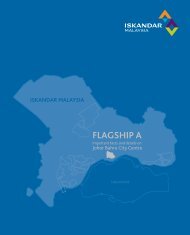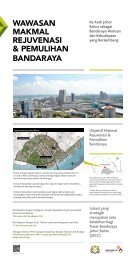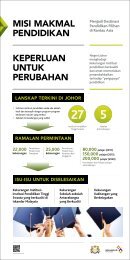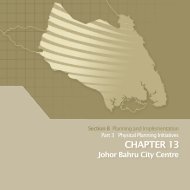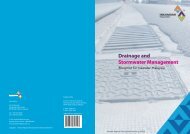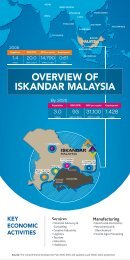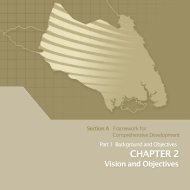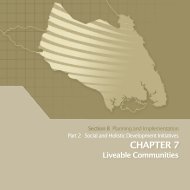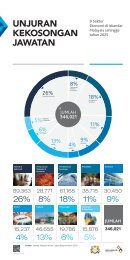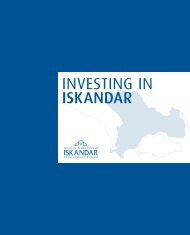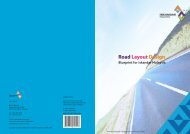Sistem Rangkaian Urban - Iskandar Malaysia
Sistem Rangkaian Urban - Iskandar Malaysia
Sistem Rangkaian Urban - Iskandar Malaysia
You also want an ePaper? Increase the reach of your titles
YUMPU automatically turns print PDFs into web optimized ePapers that Google loves.
Section B Planning and Implementation<br />
Part 4 Infrastructure Development Initiatives<br />
CHAPTER 15<br />
<strong>Urban</strong> Linkage System
<strong>Urban</strong> Linkage System<br />
chapter<br />
15<br />
15.1 Introduction<br />
<strong>Urban</strong> linkages are pivotal to achieve balanced economic growth<br />
within SJER. A functional urban linkage system will need to address two<br />
key fundamental issues - the movement of goods and the movement of<br />
people.<br />
In recent times, several major road networks have already been<br />
proposed, for example, the Eastern Dispersal Link (EDL), Johor Bahru<br />
Coastal Road and the Johor Bahru Middle Ring Road. In addition,<br />
relevant and pertinent road upgrading and improvement programmes<br />
have been recommended for many of the roads where economic<br />
activities are envisaged to increase.<br />
Investments in urban linkages will continue to be important especially<br />
on road systems to meet freight and personal mobility needs. Car use<br />
is still important, however priority of investment in road systems should<br />
be towards improving the safety of roads, managing roads, as well as<br />
providing alternative linkages where lacking. Road networks should<br />
be safe, efficient and attractive. This must complement investment<br />
in comprehensive pedestrian networks as part of the urban linkage<br />
system. This integrated urban linkage system must be given priority to<br />
enhance the quality of living in SJER.<br />
URBAN LINKAGE GOAL<br />
SJER Integrated <strong>Urban</strong> Linkage System ensures local community<br />
accessibility for better quality of life and contributes towards<br />
balanced economic growth.<br />
15.2 Road Networks<br />
Traffic movement in an urban area is, in general a function of roadway<br />
capacity, vehicle ownership, the availability and convenience of<br />
public transport options, land use along these routes and local traffic<br />
management regimes. It is reasonable to anticipate that private vehicle<br />
usage will increase in tandem with projected increases in vehicle<br />
ownership.<br />
In order to ensure that SJER enjoys the maximum benefits from ongoing<br />
as well as planned development projects; it is imperative to manage,<br />
improve and upgrade relevant road networks to cater for the new<br />
developments.<br />
Road network is a multi-functional space, providing enclosure and<br />
activity, as well as movement. Traditionally, the road or street is an area<br />
of public realm that provides for society interactions and activities. This<br />
principle shall be translated into implementation of road development<br />
in SJER to take account of the needs of all users; vehicular and<br />
pedestrian including the handicapped. This involves creating a street<br />
network that not only works for vehicles and public transport but also to<br />
attract a high level of use by pedestrians and cyclists.<br />
KEY DIRECTION:<br />
UL 1: Planning and development of road network in SJER emphasises<br />
on the key principles of connectivity and functions of road spaces to<br />
achieve safe, efficient and attractive road networks<br />
Highly interconnected street networks provide effective means of<br />
connectivity and accessibility of movement within an urban area.<br />
Connectivity refers to how an area can be connected from one place<br />
to the other. Highly connected street networks provide alternative<br />
routes or choices for vehicles, as well as pedestrians. It also allows for<br />
more dispersal and distribution of traffic rather than concentrating it<br />
to one street. Connectivity can be measured through identifying the<br />
numbers of intersection per kilometre of road. Highly accessible and<br />
connected street gives the quality of permeability i.e. a number of<br />
alternative ways through a built environment.<br />
15 - 1
SECTION B<br />
PLANNING AND IMPLEMENTATION<br />
15.3 Proposed Road Network System<br />
The principles of the SJER CDP for its road development program are:<br />
■ Utilisation of existing and proposed expressway to encourage<br />
integration of the state and national road development with local<br />
SJER road program. The highways are the North South Expressway<br />
(NSE), Second Link Expressway and Senai-Desaru Expressway;<br />
■ Enhance the intra-district road linkages within Johor with<br />
synergistic integrated sub-regional development;<br />
■ Functional optimization of local road network system for intersettlement<br />
mobility within Johor Bahru District and the dispersal of<br />
growth to less developed and rural areas; and<br />
■ Improve linkages between urban centres in SJER by reducing the<br />
dependence on existing radial road where major highways are<br />
currently at over capacity.<br />
With the proposed road development program it will support the<br />
SJER spatial growth plan from CBD to secondary centres such as Pasir<br />
Gudang, Nusajaya, Tebrau and the Senai-Kulai development corridor.<br />
A. Road Network Implementation Strategy<br />
The CDP’s travel demand analysis and traffic surveys identify and<br />
synthesise the existing road network upgrading mandatory within SJER.<br />
The proposed road hierarchy plan streamlines these issues according to<br />
the CDP objectives.<br />
It is critical that the traffic and transportation improvement are<br />
implemented progressively and in an orderly and logical sequence<br />
that is commensurate with the CDP. There needs to be provision for<br />
an appropriate budget to be allocated from private development<br />
contributions, government funds and privatisation schemes to<br />
implement the proposals.<br />
B. Road Network Implementation Sequencing<br />
Improvement plans to urban linkages will be implemented in phases.<br />
The improvement plans include short-term, medium-term and long-term<br />
action plans. The program involves both upgrading of existing primary<br />
and secondary roads and the building of new primary and secondary<br />
roads to link major areas. The total length of proposed roads in the<br />
program is 423.96km with an anticipated cost of RM4.8 billion (excluding<br />
land acquisition costs).<br />
C. Ninth <strong>Malaysia</strong> Plan Projects for Roads<br />
Several projects from the identified list have been committed for the<br />
Ninth <strong>Malaysia</strong> Plan.<br />
Table 15.1: Summary of Road Infrastructure Upgrading Components<br />
and Indicative Cost Estimate<br />
Road Network<br />
System<br />
Length<br />
(km)<br />
Implementation<br />
Phase<br />
Total Cost<br />
(RM Million)<br />
Expressways 98.10 2004 – 2020 1,471.65<br />
New and Upgrading<br />
Primary Roads<br />
New and Upgrading<br />
Secondary Roads<br />
212.00 2004 – 2020 2,317.50<br />
113.85 2004 – 2020 983.65<br />
TOTAL 423.96 2004 - 2020 4,772.80<br />
Source: SJER CDP 2025<br />
No<br />
1<br />
Table 15.2: The Ninth <strong>Malaysia</strong> Plan Road Projects<br />
Name of Project<br />
Entrance to Johor State New Administrative Centre,<br />
Nusajaya from Second Link<br />
Allocation<br />
(RM Million)<br />
75.0<br />
2 Upgrade Tampoi Road 60.0<br />
3 Upgrade Ulu-Tiram-Kota Tinggi road 40.0<br />
4 Land Acquisition cost for Senai-Desaru highway 600.0<br />
5 Feasibility Study for Tg Bin-Tg Pelepas bridge 1.5<br />
6<br />
Land Acquisition Cost for Coastal Highway Johor<br />
Bahru-Danga Bay-Nusajaya (land cost)<br />
200.0<br />
7 Upgrade Skudai-Senai highway 86.0<br />
8 Traffic Dispersal – Upgrade and Road Widening 680.0<br />
9 Traffic Dispersal – Interchanges 423.0<br />
Source: Economic Planning Unit (EPU)<br />
Note : Coastal Highway is note funded by 9MP except for land acquisation<br />
15 - 2
URBAN LINKAGE SYSTEM CHAPTER 15 | PART 4<br />
Table 15.3 : Road Infrastructure Upgrading Components and Indicative Cost Estimates<br />
Priority Ref. Project<br />
1 PBa<br />
Proposed Southern Link<br />
(Pasir Gudang – Bakat Batu)<br />
Length<br />
(km)<br />
Reserve<br />
(m)<br />
No. of Lanes<br />
(Standard)<br />
Implementation<br />
Phase<br />
15.00 60 4 (R5 / U5) 2004 – 2010<br />
Cost<br />
(RM<br />
Million/Km)<br />
10.00<br />
Total Cost<br />
(RM<br />
Million)<br />
Authorities<br />
150.00 JKR<br />
2 PBb Proposed East-West Link 27.50 60 4 (R5 / U5) 2004 – 2010 10.00 275.00 JKR<br />
3 EBb<br />
Senai-Desaru Expressway (Under<br />
Construction)*<br />
49.00 60 4 (R6 / U6) 2004 – 2010 15.00 735.00 LLM (Private)<br />
4 SBe Proposed New Road of Skudai – Kulai 7.00 40 4 (R4 /U4) 2004 – 2010 9.00 63.00 JKR<br />
5 SBf<br />
Proposed New Road of Mount Austin – Ulu<br />
Tiram<br />
9.50 40 4 (R4 /U4) 2004 – 2010 9.00 85.50 JKR<br />
6 SBc<br />
Proposed New By pass Road of Tmn Desa<br />
Cemerlang - Plentong<br />
5.50 40 4 (R4 /U4) 2004 – 2010 9.00 49.50 JKR<br />
7 PBf Proposed New Road of Kulai-Senai 14.00 40 4 (R4 /U4) 2004 – 2010 9.00 126.00 JKR<br />
8<br />
SNf<br />
(J2)<br />
Upgrading of Jalan Tampoi* 7.50 40 4 (R4/ U4) 2004 – 2010 9.00 67.50 JKR<br />
9 SNe (J105) Upgrading of State Road J105 15.00 40 4 (R4 / U4) 2004 – 2010 9.00 135.00 JKR<br />
10<br />
SNb Upgrading of State Road J1 (Tampoi – CBD 7.00<br />
(J1) of Johor Bahru)<br />
40 4 (R4/ U4) 2004 – 2010 9.00 63.00 JKR<br />
11<br />
PNa<br />
45.50<br />
Upgrading of Pasir Gudang Highway<br />
(FR17)<br />
60 6 (R5 / U5) 2004 – 2010 13.00 591.50 JKR<br />
12<br />
PNb<br />
(FR1)<br />
13 PNd (FR3)<br />
14 PNe (FR3)<br />
Upgrading of Federal Road 1 (Kulai – Johor<br />
Bahru)<br />
Upgrading of Federal Road 3 (Johor Bahru<br />
- Ulu Tiram)<br />
Upgrading of Federal Road 3 (Tiram – Kota<br />
Tinggi)*<br />
26.00 50 6 (R5 / U5) 2004 – 2010 13.00 338.00 JKR<br />
4.00 50 6 (R5 / U5) 2004 – 2010 13.00 52.00 JKR<br />
3.25 50 4 (R5 / U5) 2004 – 2010 9.00 29.25 JKR<br />
15 PNc (FR94) Upgrading of Federal Road 94 11.75 50 4 (R5 / U5) 2004 – 2010 9.00 105.75 JKR<br />
16 SNc (J4)<br />
Upgrading of State Road J4 (Skudai -<br />
Gelang Patah)<br />
14.00 40 4 (R4 / U4) 2004 – 2010 9.00 126.00 JKR<br />
17 SNa (J8)<br />
Upgrading of State Road J8 (Kulai – Sungai<br />
310.50<br />
34.50 40 4 (R4 / U4) 2004 – 2010 9.00<br />
Tiram)<br />
JKR<br />
18 EBa Proposed Eastern Despersal Link 8.00 60 4 (R6 / U6) 2004 – 2010 15.00 120.00 JKR<br />
19 PBd<br />
Proposed of New Road Johor Bahru<br />
– Nusajaya<br />
11.00 60 4 (R5 / U5) 2004 – 2010 10.00 110.00 JKR<br />
20 PBe Proposed Outer Ring Road 43.00 40 4 (R5 / U5) 2016 – 2020 10.00 430.00 JKR<br />
21 PBc Proposed SELUDANG Seludang – PLUS Link 11.00 60 4 (R5 / U5) 2016 – 2020 10.00 110.00 JKR<br />
22 SBa Proposed By Ppass of Bakar Batu Pandan 3.60 40 4 (R4 /U4) 2004 – 2010 9.00 32.40 JKR<br />
23 SBb<br />
Proposed of New Road Layang-layang<br />
– Kulai<br />
10.25 40 2 (R4 /U4) 2004 – 2010 5.00 51.25 JKR<br />
24 EBc<br />
Proposed New Johor Bahru – Mersing<br />
Expressway<br />
14.50 60 4 (R6 / U6) 2016 – 2020 15.00 217.50 LLM (Private)<br />
25 EBd Proposed Seludang Expressway 26.61 60 4 (R6 / U6) 2016 – 2020 15.00 399.15 LLM (Private)<br />
TOTAL 423.96 TOTAL 4,772.80<br />
Source: SJER CDP 2025<br />
Note :*Ninth <strong>Malaysia</strong> Plan Projects<br />
15 - 3
SECTION B<br />
PLANNING AND IMPLEMENTATION<br />
Figure 15.1: Proposed Expressway Development<br />
F R O M<br />
K UA L A LU M P U R<br />
P R OP O<br />
S E D SE LU D A N G E X P R ES S WAY<br />
E2<br />
EBd<br />
TO M E R S I N G<br />
P L U S H<br />
I G H W A Y<br />
E2<br />
KULAI<br />
SKUDAI<br />
SENAI<br />
E2<br />
E2<br />
S E N A I D E S A R U - E X P<br />
E2<br />
ULU<br />
TIRAM<br />
R E<br />
S S W AY<br />
EBc<br />
-<br />
P R O P O S ED J B<br />
M E R S I N G E XP R E S S WAY<br />
EBb<br />
TO D E S A R U<br />
PEKAN<br />
NENAS<br />
GELANG<br />
PATAH<br />
S E C O N D<br />
L I N K<br />
E2<br />
NUSAJAYA<br />
JB CITY CENTRE<br />
P R O P O S E D E A S T E R N<br />
D I S P E R S A L L I N K<br />
EBa<br />
PASIR<br />
GUDANG<br />
TG. LANGSAT<br />
TG. PELEPAS<br />
EXISTING EXPRESSWAY<br />
PROPOSED EXPRESSWAY<br />
Source: SJER CDP 2025<br />
15 - 4
URBAN LINKAGE SYSTEM CHAPTER 15 | PART 4<br />
Figure 15.2: Proposed Primary Road Development<br />
F R O M<br />
K UA L A LU M P U R<br />
P R OP O<br />
S E D SE LU D A N G E X P R ES S WAY<br />
PNc<br />
TO M E R S I N G<br />
P L U S H<br />
I G H W A Y<br />
PBe<br />
KULAI<br />
PNb<br />
SENAI<br />
PBf<br />
SKUDAI<br />
PNh<br />
S E C O N D<br />
PNf<br />
P R O P O S E D S E N A I D<br />
PBc<br />
ULU<br />
TIRAM<br />
ES<br />
A RU -E<br />
PNe<br />
X<br />
P<br />
R E S S W A Y<br />
PBb<br />
-<br />
P R O P O S ED J B<br />
M E R S I N G E XP R E S S WAY<br />
PBe<br />
TO D E S A R U<br />
PEKAN<br />
NENAS<br />
L I N K<br />
PBd<br />
JB CITY CENTRE<br />
PBa<br />
PNa<br />
PASIR<br />
GUDANG<br />
GELANG<br />
PATAH<br />
NUSAJAYA<br />
TG. LANGSAT<br />
TG. PELEPAS<br />
PROPOSED NEW PRIMARY ROAD<br />
PROPOSED UPGRADING PRIMARY ROAD<br />
Source: SJER CDP 2025<br />
15 - 5
SECTION B<br />
PLANNING AND IMPLEMENTATION<br />
Figure 15.3: Proposed Secondary Road Development<br />
F R O M<br />
K UA L A LU M P U R<br />
SBb<br />
TO M E R S I N G<br />
P L U S H<br />
I G H W A Y<br />
KULAI<br />
SNa<br />
ULU<br />
TIRAM<br />
SENAI<br />
SKUDAI<br />
Pf<br />
SNe<br />
SBf<br />
PEKAN<br />
NENAS<br />
SBe<br />
SNb<br />
SNf<br />
JB CITY<br />
CENTRE<br />
SBa<br />
SBc<br />
PASIR<br />
GUDANG<br />
TO D E S A R U<br />
GELANG<br />
PATAH<br />
SNc<br />
NUSAJAYA<br />
TG. LANGSAT<br />
TG. PELEPAS<br />
SECONDARY ROADS<br />
PROPOSED NEW PRIMARY ROAD<br />
PROPOSED UPGRADING PRIMARY ROAD<br />
Source: SJER CDP 2025<br />
15 - 6
URBAN LINKAGE SYSTEM CHAPTER 15 | PART 4<br />
15.4 Junctions and Interchanges<br />
Figure 15.4: Streetscapes in Johor Bahru<br />
Modern traffic signal control systems are available to allow a series<br />
of diverse functions which cater for the continually changing traffic<br />
patterns at various times of the day within a city. Systems are available<br />
to link the number of signalised junctions proposed for the Johor<br />
Bahru District to the Traffic Control Centre. The existing control centre<br />
operated by Majlis Bandaraya Johor Bahru is located at the Metropolis<br />
Tower along Jalan Abdullah Tahir.<br />
Monitoring can also be carried out using a Closed Circuit Television<br />
(CCTV) Surveillance network. The CCTV networks are used to monitor<br />
the traffic flow data and congestion levels continuously to verify and<br />
validate the system’s performance. Further adjustments may then be<br />
made to the system to enhance its performance. Priority measures for<br />
bus lanes and emergency vehicles can also be incorporated.<br />
Detailed analysis has been prepared for each junction located within<br />
the SEC. Table 15.4 shows the location of each of the major intersections<br />
analysed with recommended lane turning directions, number of lanes<br />
and recommended queue and weave lengths. Each intersection<br />
should be re-analysed prior to implementation using the latest surveyed<br />
traffic volume at that time and projected volumes from the future<br />
projection traffic analysis.<br />
Table 15.4: Summary of Intersection Infrastructure Upgrading<br />
Components and Indicative Cost Estimates<br />
Implementation Phase<br />
Nos Numbers & Type<br />
of Intersection<br />
Cost (RM<br />
Million)<br />
• Short-Term Proposal (2006–2010)<br />
21 Interchanges 1,276.00<br />
3 Signalised Junctions 10.50<br />
• Long-Term Proposal (2016–2025)<br />
3 Interchanges 150.00<br />
2 At-Grade Junctions 5.50<br />
TOTAL COST 1,442.00<br />
Source: SJER CDP 2025<br />
Source: SJER CDP 2025<br />
15 - 7
SECTION B<br />
PLANNING AND IMPLEMENTATION<br />
Table 15.5: Detailed Intersection Infrastructure Upgrading Components and Indicative Cost Estimates<br />
Ref. No.<br />
1 Pandan Diamond Interchange<br />
Intersection<br />
Short-Term Proposal<br />
(2006-2010)<br />
3-Tier Diamond Interchange<br />
(Under Construction)<br />
Long-Term Proposal<br />
(2016 – 2025)<br />
Cost<br />
(RM Million)<br />
Authorities<br />
140.0 JKR<br />
2 3-arm Signalised Junction of Jalan Tebrau / Jalan Bakar Batu 2-Tier Half Diamond Interchange 50.0 JKR<br />
3 Trumpet Interchange of Jln Pekeliling Pasir Gudang Cloverleaf Interchange 30.0 JKR<br />
4 Intersection of Southern Link / Jalan Kota Diamond Interchange 50.0 JKR<br />
5 Intersection of Southern Link / Jalan Permas Utara Diamond Interchange 50.0 JKR<br />
6 Intersection of Jalan Southern Link / Eastern Dispersal Link (EDL) Diamond Interchange 50.0 LLM (Private)<br />
7<br />
8<br />
Intersection of East-West Link / By-pass Road of Desa Cemerlang<br />
– Plentong<br />
Intersection of East-West Link/ New Road of Mount Austin – Ulu<br />
Tiram<br />
9 3-Arm Signalised Junction of Skudai Highway / Jalan Pontian<br />
4-Arm Signalised Junction<br />
3.5 JKR<br />
4-Arm Signalised Junction 3.5 JKR<br />
3-Tier Modified Trumpet<br />
Interchange (Under Construction)<br />
100.0 JKR<br />
10 Intersection of East-West Link / State Road J105 4-Arms Signalised Junction 3.5 JKR<br />
11 Intersection of Senai – Desaru Expressway / State Road J10 Double Trumpet Interchange 100.0 LLM (Private)<br />
12 Intersection of Senai – Desaru Expressway / Federal Road 3<br />
13<br />
Intersection of Senai – Desaru Highway/ New Road of Mount<br />
Austin – Ulu Tiram<br />
Double Trumpet Interchange<br />
(Under Construction)<br />
100.0 LLM (Private)<br />
Overpass 18.0 LLM (Private)<br />
14 Intersection of Senai – Desaru Highway / State Road J105 Overpass 18.0 LLM (Private)<br />
15 Intersection of Senai – Desaru Expressway / Federal Road 16 Diamond Interchange 50.0 LLM (Private)<br />
16 Intersection of Senai – Desaru Highway / Second Link Modified Cloverleaf Interchange 60.0 LLM (Private)<br />
17 3-Arm Signalised Junction of Jalan Tampoi / Jalan Tebrau 3-Tier Trumpet Interchange 40.0 JKR<br />
18<br />
19<br />
4-Arm Signalised Junction of Jalan Datin Halimah / Jalan<br />
Tampoi<br />
Left Turn Junction of Jalan Kampung Maju Jaya / Taman Sutera<br />
/ Skudai Highway<br />
3-Tier Diamond Interchange 60.0 JKR<br />
Diamond Interchange 50.0 JKR<br />
20 Perling Diamond Interchange 3-Tier Diamond Interchange 100.0 JKR<br />
21 Larkin Cloverleaf Modified Cloverleaf 50.0 JKR<br />
22 RAT Auto Interchange Modified Trumpet Interchange 50.0 JKR<br />
23 Tiram 4-Arm Signalised Junction Diamond Interchange 50.0 JKR<br />
24<br />
Intersection of New Road Johor Bahru – Nusa Jaya / Jalan<br />
Tebrau<br />
3-Tier Diamond Interchange 60.0 JKR<br />
25 Intersection of Outer Ring Road / Federal Road 94 3-Arm Signalised Junction 3.0 JKR<br />
26 Intersection of Outer Ring Road/ Federal Road 1 Roundabout 2.5 JKR<br />
27 Intersection of Outer Ring Road / North – South Highway Trumpet Interchange 50.0 LLM (Private)<br />
28<br />
Intersection of Johor Bahru – Mersing Expressway / Senai<br />
– Desaru Expressway<br />
Double Trumpet<br />
Interchange<br />
TOTAL COST 1,442.0<br />
Source: SJER CDP 2025<br />
100.0 LLM (Private)<br />
15 - 8
URBAN LINKAGE SYSTEM CHAPTER 15 | PART 4<br />
Figure 15.5: Proposed Upgrading Existing Interchanges and Proposed New Interchanges<br />
Kota Tinggi District<br />
E2<br />
26<br />
27<br />
25<br />
E2<br />
E3<br />
16<br />
15<br />
E2<br />
14<br />
10<br />
13<br />
8<br />
23<br />
12<br />
28<br />
9<br />
E2<br />
Pontian<br />
District<br />
19<br />
20<br />
18 17<br />
21<br />
2<br />
22<br />
6<br />
5<br />
4<br />
3<br />
E3<br />
PROPOSED NEW INTERCHANGE<br />
PROPOSED UPGRADE INTERCHANGE<br />
SJER BOUNDARY<br />
Source: SJER CDP 2025<br />
15 - 9
SECTION B<br />
PLANNING AND IMPLEMENTATION<br />
▼ Cyclist and Pedestrian Facilities<br />
Pedestrian facilities include those located within street right of-ways<br />
that are adjacent to or parallel with the roadway, such as sidewalks,<br />
walkways, and roadside shoulders used for pedestrian travel. Sidewalks<br />
and walkways function as integral components of pedestrian-friendly<br />
street systems where pedestrians can experience safety, comfort,<br />
accessibility, and efficient mobility. Sidewalks and walkways increase<br />
pedestrian safety by separating pedestrians from vehicle traffic. Wide<br />
shoulders may be installed in some locations as an interim solution when<br />
it is not feasible to build a full sidewalk improvement.<br />
Pedestrians want facilities that are safe, attractive, convenient, and<br />
easy to use. Good pedestrian details attract more pedestrians, thus<br />
making urban areas feel safer and helping commercial areas succeed.<br />
B. Barrier Free Pedestrian Route<br />
Providing a safe pedestrian environment is a development priority<br />
for SJER in order to provide quality built environment for residents<br />
and visitors. The design of ‘Safe Street’ in SJER will take account of<br />
the provision of dedicated pedestrian walkways that are barrier<br />
free for all groups of people including the handicapped. This is<br />
to be incorporated in the provision of clear sidewalk zone along<br />
primary and secondary pedestrian routes connecting places of<br />
interest and focal points for pedestrians.<br />
Figure 15.6: Examples of Facilities for the Handicapped along<br />
Pedestrian Route<br />
KEY DIRECTION<br />
UL 2: Priority for pedestrians and cyclists<br />
A. Pedestrian in <strong>Urban</strong> Areas<br />
Development plans for urban areas should provide for pedestrian<br />
linkages with many walkways segregated from traffic, such as overhead<br />
walkways which are directly connected to buildings. Most journeys<br />
by public transportation require passengers to get off and walk the<br />
last leg to their desired destination. Covered walkways, which provide<br />
a pleasant environment to walk in, would be an attractive feature<br />
for pedestrians. This alternative is practical and affordable in terms<br />
of construction and operating costs, and would greatly encourage<br />
walking in urban areas. Pedestrians of urban areas together with special<br />
preferential access for public transport should be developed to limit the<br />
use of automobiles. Providing the right environment for pedestrians and<br />
cyclists is crucial. A sense of comfort, safety and convenience need to<br />
be deployed. Hence, more space should be allocated for pedestrian<br />
and cyclist lanes.<br />
Source: SJER CDP 2025<br />
Clear Sidewalk Zones are zones within the streetscape where<br />
pedestrian flow is continuous and uninterrupted by any structures<br />
such as columns or any landscape furniture such as trees,<br />
benches, kiosks and utility elements such as covers and gratings.<br />
15 - 10
URBAN LINKAGE SYSTEM CHAPTER 15 | PART 4<br />
The design of new, or improvements to, existing pathways in SJER is<br />
to provide clear, obstruction-free, level and wide pathways for the<br />
convenience of all users, especially the sightless and people with<br />
mobility problems. Design and development of pedestrian routes and<br />
facilities along primary and secondary pedestrian routes will incorporate<br />
and implement the criteria and guidelines as specified by the MS<br />
1331:2003, Code of Practice for access of disabled persons outside<br />
buildings in order to create a pedestrian environment that is accessible<br />
and useable by all.<br />
Figure 15.7:<br />
Requirement for Access for the Handicapped within<br />
Sidewalk<br />
• The minimum width of an<br />
unobstructed pathway should be<br />
0.90 m.<br />
• The minimum width of a two-way<br />
wheelchair traffic passage is<br />
1.50 m. The preferable width is<br />
1.80 m .<br />
Source: MS 1331:2003, Code of Practice for access of disabled persons outside<br />
buildings<br />
C. Bicycle way<br />
Bicycle ways within the Johor Bahru District will promote cycling<br />
for recreation and personal transport provided that these facilities<br />
are attractive and safe. The promotion of travel by bicycle to work<br />
destinations will result in fewer car trips.<br />
A bicycle way network can be incorporated into the road hierarchy<br />
via limited access streets where reduced speed limits for motor vehicles<br />
are proposed, by the provision of cycle facilities integrated with the<br />
footpath network, and by parking and storage that is secure and<br />
conveniently located. A fully segregated cycle network, such as along<br />
the foreshore, incorporated into a wider network outside the Central<br />
District would be utilised for both recreational and work-based trips.<br />
15 - 11



